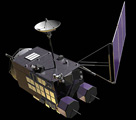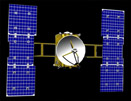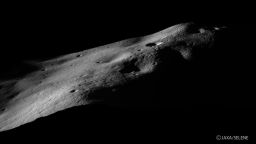Emily Lakdawalla • Mar 11, 2008
LPSC: Kaguya sessions
It's time to begin dismantling my notes from attending the Lunar and Planetary Science Conference on Monday. I want to take my time working through my notes from the MESSENGER sessions and go back and find illustrations (as the team apparently did not think to issue press-release images related to their talks!) so I'll work first on two smaller batches of notes, one set from the afternoon session on the Kaguya mission and another on a potpourri of Saturnian satellites.
I have to say I was a bit disappointed by the Kaguya session. Nearly every image that was shown has been available on their website for months, and most of the talks spent most of the time summarizing the capability of the instruments, not in displaying any new science results or data products. Having said all that, I think that just summarizing the mission was important. In casual conversation with several conference attendees it became clear to me that even space scientists aren't aware how ambitious a mission Kaguya is -- most people assume it's similar to Hayabusa, which was just a technology demonstration mission.
So, in case you share that impression, let me establish that Kaguyais not Hayabusa. Kaguya is huge, with a launch mass of three tons. It has 14 instruments and deployed two mini-satellites. It's designed to obtain images, topographic maps, compositional maps, study the magnetic field, lunar space environment, and obtain the best gravity maps of the Moon yet.
  ittle ion-powered Hayabusa (right) is dwarfed by its solar panels. Kaguya (left) is a much larger spacecraft. |
The second presentation was given by Makiko Ohtake on the first results from the Multiband Imager. This is a camera that obtains color images in five wavelengths at 20 meters per pixel (the wavelengths being 415, 750, 900, 950, and 1000 nanometers) and four at 62 meters per pixel (1000, 1050, 1250, and 1550 nanometers) in swaths 19.3 kilometers wide. She reported that the in-flight performance of the Multiband Imager has been outstanding; the properties of the camera do not appear to have changed since it was tested in the laborator (its dark current and flat field match preflight data), and that no bad pixels have been identified, and no stray light has been observed. To date, they have mostly acquired images in polar regions. She showed some beautiful images of a region within Mare Procellarum where the camera resolves boulders and ejecta blocks sitting about the landscape; she picked out point spectra to demonstrate that some little tiny craters and boulder clumps were made of fresher (less weathered) material than the surrounding lunar soil. That is going to be one beautiful data set.
 Perspective view of the first Kaguya Terrain Camera image from the Moon Kaguya's terrain camera not only gathers high-resolution images of the Moon, it does so twice from different perspectives, permitting the calculation of the three-dimensional shape of the terrain. This image is from the lunar farside, of a region 30 kilometers from the south pole. Credit: JAXA / SELENE |


 Explore Worlds
Explore Worlds Find Life
Find Life Defend Earth
Defend Earth

